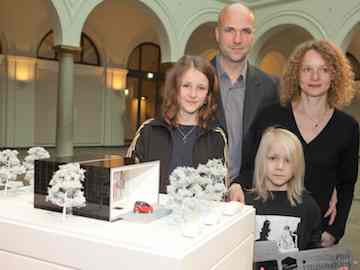
How different is life in a super-efficient home designed to generate more energy than it consumes? The Welke family in Berlin are guinea pigs in a social experiment.
For 42-year-old Jörg Welke, it’s a dream come true. Shaped like a cube and featuring a lot of glass, Welke’s temporary new home looks more like an oversized designer-stereo than a house. A black touchscreen on the wall is the first thing a visitor notices when entering the “efficiency plus” home. The control center allows the family to regulate its energy needs including lights, shutters, appliances and heating.
Welke, along with his wife and two children, are part of a pilot project that aims to see how comfortably a typical family can live in a dwelling designed to optimize its use of energy and eliminate the need for fossil fuels.
Emissions-free and off the grid
The main source of power is a solar array on the roof. In conjunction with appliances that only use energy when needed, the setup delivers 16,500 kilowatt-hours (kwh) of electricity per year – far more than the 2,000 kwh that the family previously needed.
The rest is used to power the family’s two electric cars and electric bicycles parked in the garage. Any energy still left over can be sold back to the grid. “It’s a good feeling when you know that you’re driving completely emissions-free,” said Welke. “We’re not getting energy from an eco-provider – we’re actually producing it here ourselves,” he told DW.
The house depends on automated, well-timed use of appliances and a system of batteries to make use of solar energy when the sun isn’t shining.
Right now the batteries are a work in progress.
“This is a research project, it’s the first battery of its kind,” says Welke, slapping the lid on a hulking grey structure in the yard made from a dozen old car batteries.
Theoretically, it could provide the household with energy for a week, if the weather were too bad for the solar array.
“We’re completely off the grid,” Welke said. So far they’ve made it through winter, which is a good sign for summer.
Children can save energy too
The futuristic home is an adventure for 12-year-old Freyja and 8-year-old Lenz. Freyja brags about her daily solar-powered bath on her blog. Simone Wiechers admits that her daughter doesn’t actually bathe every day, but says the family no longer worries about where the power to heat the bath comes from.
“Before, we would carefully consider if the bath was worth it,” Weichers said, echoing her husband’s guilt over burning fossil fuels for a spot of luxury.
The home is also aesthetically appealing, surrounded by a large green yard in downtown Berlin, near the zoo. The two-storey, glass-fronted designer house stands out in a neighborhood of apartment complexes. The glass helps save energy by working with as much natural light as possible.
Inside, the home features wooden floor boards, but the main draw for the couple was the high-tech design.
“Because it’s automatic, it saves energy,” Welke said. Motion sensors turn lights on when they’re needed, and household appliances switch themselves on at the most convenient time to exploit surplus power. With the home heavily insulated to prevent energy waste, an automatic ventilation system ensures the house maintains a comfortable temperature.
Wireless charging
Whether cars or smart phones, the house is full of gadgets waiting to be charged. A tangle of cables makes this possible – except for outdoors, where an induction coil can charge the family’s electric vehicles wirelessly through a metal plate.
“I don’t have to do anything, I just park the car and the next day it’s charged,” Welke said.
Before, Welke used to consider such things superfluous gadgetry. But since the family started making regular trips with the electric cars, they’ve had to start thinking about things like where to charge for a trip longer than 150 kilometers (93 miles). In the countryside, there are virtually no high-voltage outlets for recharging electric cars. Even if they find one, a full charge can take nine hours.
It’s no wonder “got a spare power point handy?” has become a kind of family catchphrase.
Test period
The family is also discovering unanticipated challenges, which is exactly what they’re supposed to do. One of those hiccups came when the family took a trip to Lychen in their electric car, about 100 kilometers away. The car’s charge seemed to be running down far faster than it should have. The reason turned out to be a bicycle carrier, which reduced the vehicle’s aerodynamics. This kind of information is helpful for the project’s organizers, Germany’s Federal Ministry of Transport, Building and Urban Development, which estimates that homes and transportation together account for around 70 percent of Germans’ energy use.
The pilot project, which started in September 2011, is supposed to last for two years.
After that, the Welke-Weichers will have to readjust to life back in their old place in Berlin’s Prenzlauer Berg.

One Response
is it possible to visit?